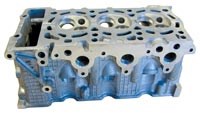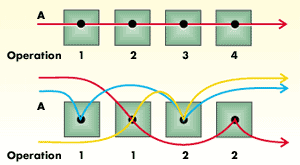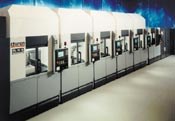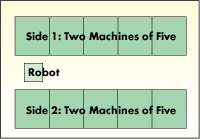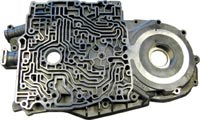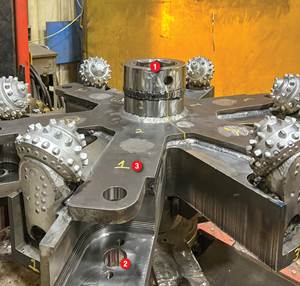Agile Or Lean?
Either way, machining centers may make sense. When CNC machines are used for high-volume work, this question comes first.
Share


There are different ways to apply CNC machining centers to high volume work. One way is for the machines to operate in series. Each machine in the sequence can perform a different portion of the machining required, with operators transferring the part from machine to machine so that every workpiece sees every machine in the line.
Another way is for the machines to operate in parallel. A cell controller can direct an automated work handling system to deliver the part to any one of a number of interchangeable machines, with each machine performing all of the necessary cutting for whatever workpiece it happens to see.
These two examples don’t capture every possible machining center arrangement for high-volume work. However, the examples do serve to illustrate the two basic, competing philosophies that describe any production configuration. Those two philosophies can be labeled lean and agile.
In most respects, the part suggests its own process. The manufacturing engineer looks at the design requirements of the part to determine the most effective way for that part to be machined. However, the question of lean versus agile is one choice that the part itself rarely, if ever, dictates. A given part might just as well be an agile part as a lean one. Instead, it would be more accurate to say that different companies, or different facilities, lend themselves differently either to the lean or the agile approach.
At least that is the experience of project engineering manager Norm Holtzhauer, whose observations serve as the source for the information conveyed here. Mr. Holtzhauer works for Chiron America (Charlotte, North Carolina), a machine tool builder offering vertical machining centers that are sold as part of turnkey-engineered high-volume machining processes. As such, this builder’s offerings generally compete for business with dedicated transfer lines and with CNC systems using horizontal machining centers. With regard to the transfer lines an advantage machining centers offer is that they are easier to change over when the part design changes—an important advantage as product life cycles shrink. And with regard to the horizontal machining centers, a vertical machine can permit a more stable cut. It can let the spindle get closer to the workpiece. However, there is a tradeoff—a horizontal machining center with a tombstone fixture can accommodate many more workpieces in one batch. To compensate for this difference, Chiron offers machines using toolchangers and workchangers generally much faster than those to be found on machines that were not designed specifically with high volume production in mind.
But just like the parts they produce, these machines, too, are not inherently lean nor agile. Mr. Holtzhauer has applied machining centers effectively in arrangements that are purely sequential, purely parallel, and somewhere in between.
In fact, in this part of the turnkey decision-making process, it’s rare that he makes any recommendation at all. Instead, customers tell him which alternative they prefer. Many companies favor a lean approach because this appears to be the less expensive of the two. And in many cases, it is. A lean arrangement of CNC machines can indeed save cost over the long term, he says. But the chance of realizing these savings greatly increases if the processes that everywhere surround and support this lean line also follow a lean approach.
How Many Paths?
Let’s define the terms. At least in this context, lean has a specific meaning. A lean configuration is one in which the part can see only one possible route through the series of machining centers. For example, if the process is set up so a given hole might be drilled at this machine or that machine, and if the operator or the cell controller can hold off on deciding which machine will drill the hole until just before the time comes for that operation, then this is not a lean process.
Instead, a lean configuration of machining centers is suggestive of the dedicated transfer line’s approach to machining. The part stops at one machining center after another in sequence, and it receives nearly an equal portion of machining (in terms of cycle time) at each stop. The work can be moved from machine to machine using a loading and unloading vehicle, or—particularly in plants committed to maintaining a certain staffing level—parts can be moved from machine to machine by human operators.
An agile arrangement is any other machining center configuration. An agile cell, or an agile grouping of unconnected machining centers, can be one in which every machine is set up to perform all of the machining a given part requires, so the part stops at one and only one machine. However, an agile configuration can also be one in which half of the available machining centers are set up to perform side-one machining, and the other half are set up to machine side two. In this case, even though machines are used in series, the process is still agile, because the part can go to any one of multiple machines for the first operation, then to any one of the remaining machines for the second operation.
In an agile configuration, the part can take more than one route through the process.
Costs And Choices
What this means is that an agile line can keep producing finished parts if a machine goes down (albeit at a reduced productivity). However, a lean line, by definition, must stop altogether if any one machine is incapacitated. And this characteristic of a lean process is what leads many manufacturers to choose agility instead.
But the lean process does have its advantages. The whole idea behind a lean approach is that agility, or flexibility, does not come for free. Wherever alternate options are available, there are prices to be paid for keeping those options open. With an agile process, for example, there is the need to maintain tooling at one machine that is redundant with tooling at another. In addition, troubleshooting is more difficult. Either a system must be put in place for tracking workpieces according to what machines touched them, or else service technicians may have to look at multiple machines when a problem is identified. If suddenly that drilled hole is out of spec coming off an agile line, and no workpiece tracking mechanism is in place, then every machine set up to drill that particular hole is potentially a culprit. By contrast, on a lean line, which machine is responsible for the error is immediately clear. It’s the one machine in the sequence set up to drill that particular hole.
But “lean” is a philosophy that shouldn’t be adopted halfway, Mr. Holtzhauer says. In a plant in which some systems are lean and some are agile, psychology alone can make the lean line more difficult to keep running at its intended efficiency. No matter what role the employees take—whether they service an automatic line, or whether they transfer work between machines—employees will have to interact with the lean line in some capacity, and the lean line places constraints on these employees. An open machine must be loaded promptly, and a down machine must be serviced right away. And in a company or a facility in which there are also agile systems that do not make these same demands, asking the workforce to keep a foot in both worlds may lead to inefficiencies that a purely lean process wouldn’t see.
In fact, the difference in employees’ roles for a lean configuration versus an agile one was illustrated by an experiment that involved the automobile transmission housing part shown in the first photo in this article. The manufacturer devoted 42 machining centers to this part and initially split the machines equally among two different configuration strategies. Twenty-one machines made a lean line and 21 made an agile line. In the lean line, 21 clampings were required to complete the part.
Every 48 seconds, an operator would unload the part from one machine and clamp it on the next machine. By contrast, the agile line consisted of seven cells of three machines each. The part had to hit one machine in each of the seven cells, but which machine didn’t matter. In this line, operators moved the work only once every 150 seconds. The reduced demand on the operators made it easier for them to perform effectively. And ultimately, this manufacturer went to a completely agile approach by converting the lean line to match this agile line’s method.
Time And Money
But the transmission housing example points out another important difference between lean and agile systems. With a lean approach, the number of times the work is moved is higher, while the time the workpiece spends at each machine—that is, the time available for this movement to happen—goes down. That’s why, in many lean systems, time spent moving the work from machine to machine actually determines the rate of production. In automated lean lines, for example, the loading and unloading vehicle often sets the pace.
The specific example of this transmission housing application also illustrates something about the economics of the two approaches. The agile approach can sometimes offer savings of its own. When each machine takes on more of the machining work, less time is lost by machines that are kept waiting when workpieces fail to arrive in time. In some cases, this can let a smaller number of machining centers meet production targets. This was the case with the transmission housing part. When the process was converted to an all-agile approach, the plant was able to eliminate three of the machines.
Related Content
DN Solutions Acquires Heller to Boost Global Machine Tool Market Presence
DN Solutions integrates Heller Group, leveraging a 130-year legacy to enhance machining center technology and expand customer reach.
Read MoreFANUC Details Robotic Vision, ROBODRILLS and More at IMTS 2024
FANUC’s IMTS 2024 booth includes real-time demonstrations that show the abilities of its equipment, including robots, controllers and machine tools.
Read MoreThree-Axis Bridge Mill Opens New Doors for Construction OEM
Different industries often require different machining priorities, a truism recently demonstrated by Barbco, an OEM of heavy-duty boring equipment that opened up new design possibilities by pivoting toward rigid, less complex machining centers.
Read MoreThe Cut Scene: The Finer Details of Large-Format Machining
Small details and features can have an outsized impact on large parts, such as Barbco’s collapsible utility drill head.
Read MoreRead Next
OEM Tour Video: Lean Manufacturing for Measurement and Metrology
How can a facility that requires manual work for some long-standing parts be made more efficient? Join us as we look inside The L. S. Starrett Company’s headquarters in Athol, Massachusetts, and see how this long-established OEM is updating its processes.
Read More












